The cosmos is huge and immense. Nevertheless, for the second century humanity has been trying to conquer it and every year creates new projects, invests money in them and trains astronauts. But today we will not talk about distant objects, unknown planets, stars or nebulae. We will talk about what humans have created and what has been “accompanying” our Earth for almost eighteen years now. Let's talk about the International space station(or just ISS). We are sure that at least once in your life, you have heard this abbreviation. Mostly in scientific programs or articles. The ISS has been in space since 1998 and during that time has experienced various deformations in the form of extensions, minor accidents and even a wedding! We will tell you about these and other facts further.
What the ISS looks like
The very first element of the station was sent into orbit on November 20, 1998. It was the Zarya functional cargo block produced by Russia. But already at the beginning of December, the Unity module (USA) was attached to the ISS, and three days later the first people appeared at the station - the American Robert Kabana and the Russian Sergei Krikalev. Further extensions began in 2000. Actually, in 1999, the ISS changed a lot, which you can observe in the photographs. On the left is the ISS in 1999, and on the right - already in 2011.

ISS personal website
Naturally, such a large project should have a personal website. On the website www.iss.stormway.ru you will be able to observe the movements of the station in real time and see what is happening overboard. For example, during the time you are reading this article, the station has moved from the United States to Japan. In addition, the site has a blog of astronauts, a tour of the station, where you are told about it. And there is also news, the ability to track when the ISS will move over your city, and find out when it has already been there (there are not all cities, but you can put the closest one to you). Naturally, the site exists in two languages: English and Russian.
Life ISS
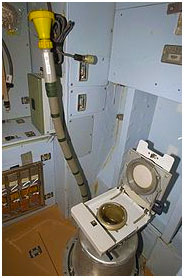
Astronauts spend months on the ISS, so they naturally have to get used to and adapt to all sorts of peculiar things. But still, they try to make their stay in space the most comfortable, so that all sorts of things familiar on earth exist there as well. For example, the same toilets work in much the same way, and waste is collected in containers and then disposed of. By the way, purely for comparison: the cost of a toilet in the American segment is about $ 19 million.
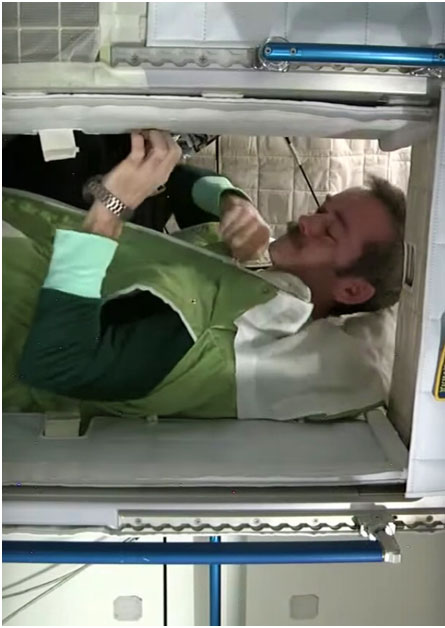
How astronauts sleep
With sleep, things are not at all the same as on Earth: astronauts sleep in peculiar bags. There is also the Internet on board (of course), with the help of which the astronauts have fun: they watch films, read the news, communicate with loved ones. But all this cannot be compared with the main hobby of astronauts - photography. Indeed, once at the top, anyone would not refuse the opportunity to take a few pictures of endless space and our Earth.
Daily routine on the ISS
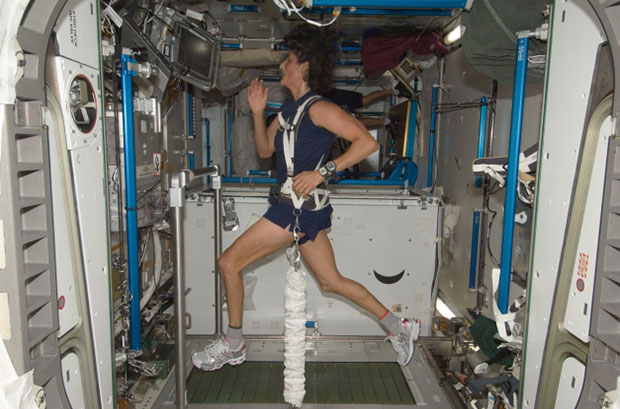
How they run on the track on the ISS
How many times we didn’t try to pull ourselves together and follow the daily routine, we didn’t succeed. But this will not work at the station. One of the astronauts in her interview talked about the daily routine when you are at the station. They get up at 7:00, and the working day ends at 19:30. Also, physical activity is mandatory for astronauts: half an hour on a treadmill and 70 minutes of strength exercises. In addition, the cosmonauts have several more simulators at their disposal.
Photo of the ISS from Earth

If you think that such a distant point as an orbital station is difficult to capture from the Earth, then you are mistaken. Having serious and good equipment on hand, you can easily remove the station with all its outlines. For example, in the photo: a snapshot of the ISS 2013, taken in Sydney.
Wedding on the ISS
![]()
The distance from Texas to the ISS is huge, but even that is not a hindrance to two loving hearts. On August 10, 2003, Russian cosmonaut Yuri Malenchenko married an emigrant who was in Texas at the time. The thing is that the cosmonaut's flight was supposed to end even after the wedding, but it was extended. Upon learning of this, the astronaut told the bride that he was not going to pull any more. So in August (as they had planned) there was a wedding ceremony on Earth.
And finally, we would like to present you some photographs taken from and on board the ISS. Big photo(and even a video) you can find on the station's official website.
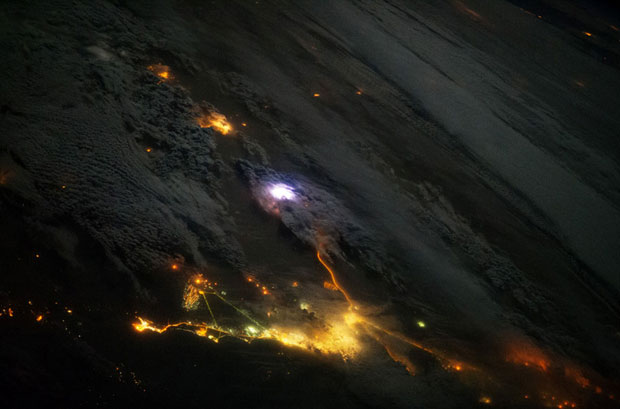



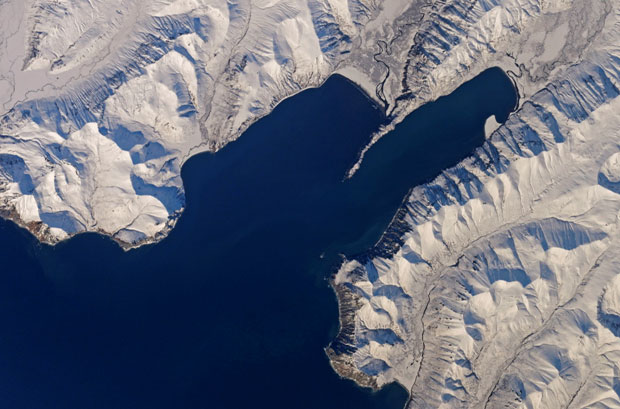
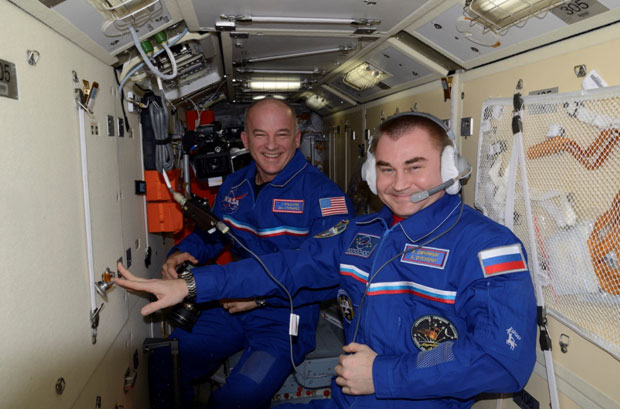
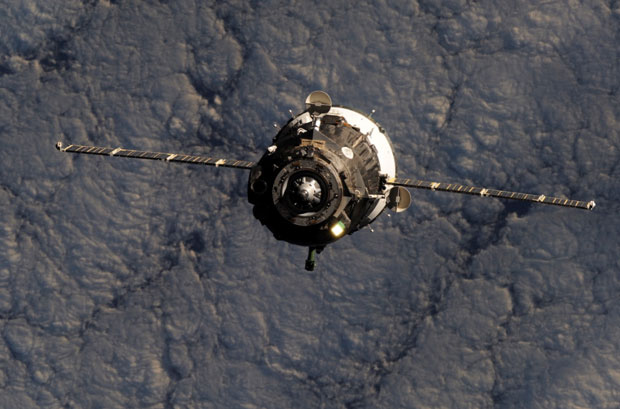



November 25th, 2016
On February 20, 1986, the famous Soviet and Russian space station "Mir" was launched and launched into near-earth orbit. Many of us still remember the constant news bulletins from orbit showing the life of Russian, American and other cosmonauts in the cramped space of our station.
In 2001, Mir, having exceeded its service life three times, was flooded. Let's remember the brightest episodes from the life of this unique project.
Mir from launch to sinking
After the first launches of people into space and a manned flight to the moon, the researchers faced the question of long-term exploration of near space. For this, it was necessary to create habitable orbital space stations, where regularly changing crews of cosmonauts could live and work.
The USSR took up this task most seriously. In 1971, the first long-term orbital station Salyut-1 was launched, followed by Salyut-2, Salyut-3, and so on until Salyut-7, which finished work in 1986 and fell to Argentina in 1991.
Soviet cosmonauts aboard the Salutes were engaged in missions, mainly of a scientific and military nature. The United States did not have such extensive experience - its only long-term orbital station, Skylab, operated from May 1973 to February 1974.
Work on the Mir space station began in the minds of Soviet designers back in 1976. The station was supposed to become the first spacecraft with a modular architecture - it was assembled directly in orbit, where the launch vehicles took its individual blocks. In theory, this technology made it possible to build an entire flying city in space with a large amount of scientific equipment and sufficient conditions for a long-term autonomous existence.
Work on the station was carried out continuously until 1984, when the country's leadership decided to throw all the cosmonautics into the Buran program. But very soon the alignment of forces changed in the opposite direction, and by the decision of the highest party officials, Mir again became number one in the queue. The station was ordered to launch exactly in time for the XXVII Congress of the CPSU, which was scheduled for late February - early March 1986.
XXVII Congress of the CPSU
A total of about 280 enterprises worked on the project under the auspices of 20 ministries and departments. They succeeded in time just in time - the launch vehicle with the first module of "Mir" was launched into the target orbit on February 20, 1986. This date is considered to be the birthday of the space station.
Orbital complex base unit, launched first, represented the main part of the station - cosmonauts lived and worked in it, from which Mir was controlled and communicated with the Earth. The rest of the modules, launched and docked later, had a narrower purpose - scientific or technical.
The first module to join the complex was Kvant. Docking with "Quant" was also the first emergency situation for the station's crew. The astronauts had to urgently go into outer space to complete the operation.
This was followed by "Kvant-2" and "Kristall", after which the assembly of the station was stopped for some time due to the collapse of the USSR and economic problems. The next modules "Spectrum" and "Nature" were launched in 1995 and 1996 only thanks to a contract with the United States - the Americans agreed to finance the project in exchange for the participation of their astronauts. Although "Mir" was originally created with plans that the station will be visited by cosmonauts from other countries, not only socialist, but also capitalist.
So, in 1987, a foreigner, the Syrian cosmonaut Mohammed Faris, flew to Mir for the first time. And in 1990, the first journalist, Toehiro Akiyama, visited the station. He also became the first Japanese person to travel to space. Moreover, several days spent at the station were not the most pleasant for Akiyama - he was susceptible to the so-called "space sickness", an analogue of the "sea disease" associated with a disorder of the vestibular apparatus. This fact revealed a deficiency in the training of non-professional astronauts.
Subsequently, the station was also visited by representatives of France, Great Britain, Austria, Germany, Slovakia, Canada, Syria, Bulgaria and Afghanistan. Surprisingly, more recently, Syria and Afghanistan flew into space!
Within the framework of the Shuttle-Mir program, American astronauts have also repeatedly visited the station. In 1995, a special docking module was delivered to the station to dock the Mir with the American shuttles.
Many records and remarkable events remain in the history of Mir. Already in 1986, a crew of two Soviet cosmonauts for the first time in history flew from one station to another - they undocked from Mir and, having covered 2500 km in 29 hours, docked with Salyut-7. This was the last expedition in the history of Salyut.
In 1995-95, cosmonaut Valery Polyakov set on Mir a still unbeaten record for a man's continuous stay in space - 437 days and 18 hours.
And the overall record for the duration of space flights belongs to another Russian - Alexei Krikalev. He also flew to Mir more than once, and once, having left the USSR, he returned to independent Russia.
In 1996, the last module, Nature, joined the station and the assembly was finally completed. It took 10 years - three times longer than the original estimated time of "Mir" operation in orbit.
According to the unofficial testimony of cosmonauts, work at the station from the very beginning was an ongoing struggle with the ever-failing Soviet electronics. But in 1997, staying at the station began to gradually turn into a real torment, especially for foreign crews. Perhaps this is why Mir station was portrayed in this way in the famous film Armageddon.
First, on a holiday for Russia on February 23, 1997, a fire broke out at the station - an oxygen bomb from the atmosphere regeneration apparatus caught fire. You can imagine the position of the astronauts - there are six people at the station, the size of a one-room apartment, and the apparatus for generating oxygen is engulfed in a fire that quickly burns this oxygen.
The inhabited compartment quickly filled with smoke, but the crew managed to react in time and correctly, putting on respirators and extinguishing the fire with a fire extinguisher. A defective oxygen bomb was later named as the cause of the fire.
Fires happened on the Mir, and before that - in 94, the record-holder Valery Polyakov even had to put out the fire with his own suit. But this time on board were guests from other countries, for whom such an emergency was a novelty. If you want to laugh, compare the American and Russian reports of that same fire. Here are just two excerpts:
But the most dangerous incident in the history of "Mir" happened on June 25, 1997. During an experiment on manual docking, the Progress M-34 cargo vehicle collided with the Spektr module, as a result of which a hole of about two square centimeters was formed in the latter. At that time, there were three people at the station - Russians Vasily Tsibalev and Alexander Lazutkin, as well as American Michael Fope.
From Earth, the astronauts were ordered to immediately seal the entrance to the damaged module, but the numerous cables running through it interfered with promptly closing the hatch. Only by cutting and undocking them, the astronauts managed to stop the air leak from the station. Due to the incident, Mir lost 40% of its electricity, which excluded almost all scientific experiments... In addition, NASA lost almost all of its equipment, as it was stored in the "Spectra". After returning to Earth, Lazutkin received the title of Hero of Russia, and Tsibalev received the Order of Merit for the Fatherland, III degree.
The following crews more than once tried to fix the module, but no one succeeded in doing this - the air was still coming out. It was only possible to fully restore the power supply of the station, despite the badly damaged solar batteries of the Spectrum module.
On August 28 of the same year, another trouble happened at the station - the Electron hydrolysis units, supplying the cosmonauts with oxygen, failed. This happened more than once before - it was after their refusal that the fire described above happened, when the astronauts had to burn oxygen bombs. The crew also wanted to do this this time, but now the checker did not work at all. In order not to tempt fate, on Earth they decided to try to fix the "Electron". This time I was lucky - the problem was just a disconnected contact.
A few days later, in September, the station's on-board computer lost its orientation in space. For the task of orientation, telescopes are installed at the station, constantly monitoring the Sun, Moon and stars, checking their position. But this time the Sun was suddenly lost for some reason by the instruments. The solar panels also lost orientation, as a result of which the station was left without a main source of energy.
The loss of orientation also meant a loss of control for the station. For a while, Mir turned into an uncontrollable pile of iron, rushing at a speed of 7.7 km / s in a state of free fall. It was possible to eliminate the malfunctions only after 24 hours.
At the beginning of 1998, the station experienced problems with the air conditioning system, as a result of which the temperature in the habitable zone rose to 32 degrees. After a long struggle with technology, the astronauts managed to lower it, but only to 28 degrees. The crew members reported to Earth that they were making too many mistakes in their work due to lack of rest.
After these events, the United States began to seriously talk about the fact that the presence of astronauts at the Russian station could be unsafe. And before that the systems of Mir, which had not been working very well, were now failing one after another in a regular mode.
At the same time, the program of the International Space Station approached its implementation - in November 1998, Russia launched the first module of the ISS, called Zarya. It was obvious that Mir was living out its day. In 1999, the last cosmonauts who left the station transferred it to autonomous mode, and the government stopped funding the orbital complex.
Of course, attempts were made to save "Mir". According to some reports, the Iranian government offered to buy the station, but Roscosmos was desperately looking for private investors.
Potential candidates included the name of a Welshman named Peter Luelin, who later turned out to be a charlatan, as well as the American businessman Walt Andersson. The latter created a company called MirCorp, but the venture failed miserably due to the lack of customers for the operation of the station.
In Russia, a fund for the salvation of the "World" was created, for which donations were accepted. However, all that was collected was small sums sent by pensioners. Despite the indignation of many Russian citizens, it was decided to flood Mir.
The station was deorbited on March 23, 2001. The wreckage of "Mir" fell into the Pacific Ocean, in a specially designated area between New Zealand and Chile. This place, with an area of several thousand square kilometers, is a kind of graveyard of Soviet and Russian spacecraft - more than 85 orbital structures have been flooded there since 1978.
Behind the fall
The wonderful Novosibirsk group Silenzium has released a new amazing video, this time, on the theme of the working Komsomol. Music - A. Pakhmutova Arrangement - Natalia Grigorieva Scriptwriter - Natalia Grigorieva, Andrey Beresnev Director - Andrey Beresnev Earlier I thought that ...
Manned Orbital Multipurpose Space Research Complex
The International Space Station (ISS), created for scientific research in space. Construction began in 1998 and is carried out in cooperation with aerospace agencies of Russia, the USA, Japan, Canada, Brazil and the European Union, and is scheduled to be completed by 2013. When completed, the plant will weigh approximately 400 tons. The ISS orbits the Earth at an altitude of about 340 kilometers, making 16 revolutions per day. The station will roughly operate in orbit until 2016-2020.
Ten years after the first space flight made by Yuri Gagarin, in April 1971, the world's first space orbital station Salyut-1 was launched into orbit. Long-term habitable stations (DOS) were necessary for scientific research. Their creation was a necessary stage in the preparation of future human flights to other planets. During the implementation of the Salyut program from 1971 to 1986, the USSR had the opportunity to test the main architectural elements of space stations and subsequently use them in the project of a new long-term orbital station - Mir.
Decay Soviet Union led to a reduction in funding for the space program, so Russia alone could not only build a new orbital station, but also keep the Mir station operational. Then the Americans had practically no experience in creating DOS. In 1993, US Vice President Al Gore and Russian Prime Minister Viktor Chernomyrdin signed an agreement on space cooperation "World - Shuttle". The Americans agreed to finance the construction of the last two modules of the Mir station: Spectrum and Priroda. In addition, the USA made 11 flights to Mir from 1994 to 1998. The agreement also provided for the creation of a joint project - the International Space Station (ISS). In addition to the Federal Space Agency of Russia (Roscosmos) and the US National Aerospace Agency (NASA), the Japanese Aerospace Research Agency (JAXA), the European Space Agency (ESA, which includes 17 participating countries), the Canadian Space Agency (CSA) took part in the project. as well as the Brazilian Space Agency (AEB). India and China expressed their interest in participating in the ISS project. On January 28, 1998, the final agreement was signed in Washington to start construction of the ISS.
The ISS has a modular structure: its different segments were created by the efforts of the countries participating in the project and have their own specific function: research, residential, or are used as storage facilities. Some of the modules, for example the American modules of the Unity series, are jumpers or serve for docking with transport ships. When completed, the ISS will consist of 14 main modules with a total volume of 1,000 cubic meters; a crew of 6 or 7 people will be permanently aboard the station.
The weight of the ISS after the completion of its construction, according to plans, will be more than 400 tons. In terms of dimensions, the station approximately corresponds football field... In the starry sky, it can be observed with the naked eye - sometimes the station is the brightest celestial body after the Sun and the Moon.
The ISS revolves around the Earth at an altitude of about 340 kilometers, making 16 revolutions a day around it. Scientific experiments are carried out on board the station in the following areas:
- Research of new medical methods of therapy and diagnostics and means of life support in zero gravity
- Research in the field of biology, the functioning of living organisms in outer space under the influence of solar radiation
- Experiments to study earth's atmosphere, cosmic rays, cosmic dust and dark matter
- Study of the properties of matter, including superconductivity.
The first module of the station - Zarya (weighs 19.323 tons) - was launched into orbit by the Proton-K launch vehicle on November 20, 1998. This module was used at the early stage of the construction of the station as a source of electricity, also to control orientation in space and maintain temperature regime... Subsequently, these functions were transferred to other modules, and Zarya began to be used as a warehouse.
The Zvezda module is the main living module of the station; it contains life support and control systems for the station. Russian transport ships Soyuz and Progress dock to it. The module, two years later, was launched into orbit by the Proton-K launch vehicle on July 12, 2000 and docked on July 26 with Zorya and the American docking module Unity-1 previously launched into orbit.
The Pirs docking module (weighs 3,480 tons) was launched into orbit in September 2001 and serves for docking of the Soyuz and Progress spacecraft, as well as for spacewalk. In November 2009, the Search module, almost identical to Pirs, docked with the station.
Russia plans to dock a Multifunctional Laboratory Module (MLM) to the station, after launching in 2012 it should become the station's largest laboratory module weighing more than 20 tons.
The ISS already has laboratory modules from the USA (Destiny), ESA (Columbus) and Japan (Kibo). They and the main nodal segments Harmony, Quest and Unnity were launched into orbit by shuttles.
Over the first 10 years of operation, the ISS was visited by more than 200 people from 28 expeditions, which is a record for space stations (only 104 people visited Mir). The ISS was the first example of the commercialization of space travel. Roskosmos, together with Space Adventures, sent space tourists into orbit for the first time. In addition, within the framework of the contract for the purchase of Russian weapons by Malaysia, Roscosmos in 2007 organized the flight to the ISS of the first Malaysian cosmonaut, Sheikh Muszaphar Shukor.
Among the most serious accidents on the ISS is the crash when the space shuttle Columbia (Columbia, Columbia) landed on February 1, 2003. Although Columbia did not dock with the ISS, conducting an independent exploration mission, this disaster resulted in shuttle flights being terminated and only resumed in July 2005. This delayed the completion of the station's construction and made the Russian Soyuz and Progress spacecraft the only means of delivering cosmonauts and cargo to the station. In addition, smoke occurred in the Russian segment of the station in 2006, and the failure of computers in the Russian and American segments was recorded in 2001 and twice in 2007. In the fall of 2007, the station crew was engaged in repairing the gap solar battery that happened while installing it.
By agreement, each project participant owns its segments on the ISS. Russia owns the Zvezda and Pirs modules, Japan - the Kibo module, ESA - the Columbus module. The solar panels, which, after completion of the station's construction, will generate 110 kilowatts per hour, and the rest of the modules belong to NASA.
The completion of the ISS construction is scheduled for 2013. Thanks to the new equipment delivered to the ISS by the Endeavor shuttle expedition in November 2008, the station's crew will be increased in 2009 from 3 to 6 people. It was originally planned that the ISS station should operate in orbit until 2010, in 2008 another date was called - 2016 or 2020. According to experts, the ISS, unlike the Mir station, will not be drowned in the ocean; it is supposed to use it as a base for the assembly of interplanetary spacecraft. Despite the fact that NASA spoke in favor of a reduction in funding for the station, the head of the agency, Michael Griffin, promised to fulfill all US obligations to complete its construction. However, after the war in South Ossetia, many experts, including Griffin, stated that the cooling of relations between Russia and the United States could lead to the fact that Roskosmos would cease cooperation with NASA and the Americans would be deprived of the opportunity to send their expeditions to the station. In 2010, US President Barack Obama announced the end of funding for the Constellation program, which was supposed to replace the shuttles. In July 2011, the Atlantis shuttle made its last flight, after which the Americans had to rely indefinitely on Russian, European and Japanese colleagues to deliver cargo and astronauts to the station. In May 2012, the Dragon ship, owned by a private American company SpaceX.
The International Space Station is a manned orbital station of the Earth, the fruit of the work of fifteen countries of the world, hundreds of billions of dollars and a dozen maintenance personnel in the form of astronauts and cosmonauts who regularly go aboard the ISS. The International Space Station is such a symbolic outpost of humanity in space, the farthest point of permanent residence of people in airless space (there are no colonies on Mars, of course). The ISS was launched in 1998 as a sign of reconciliation between countries that tried to develop their own orbital stations (and this was, but not for long) during cold war, and will work until 2024 if nothing changes. Experiments are regularly carried out on board the ISS, which yield results that are certainly significant for science and space exploration.
Throughout the history of space exploration, astronauts and cosmonauts have found themselves on the verge of death more than once. We've all heard about the Challenger and Columbia shuttle disasters and Leonov's exploits, but in fact there have been many more incidents, not necessarily gruesome deaths and not receiving media attention, on both sides of the Atlantic Ocean.
Tonight for western world- and for us this morning - three cosmonauts of the International Space Station plunged into the Russian Soyuz capsule and set off on a seven-hour journey to Earth. NASA astronaut Tim Kopra, British astronaut Tim Peak from the European Space Agency and Russian cosmonaut Yuri Malenchenko have returned home. The Trinity boarded the Soyuz at approximately 10:15 pm ET (around 5:15 pm Moscow time) and undocked from the ISS four hours later at 1:52 am ET.
On February 20, 1986, the first module of the Mir station was launched into orbit, which for many years became a symbol of Soviet and then Russian space exploration. It has not existed for more than ten years, but the memory of it will remain in history. And today we will tell you about the most significant facts and events concerning the Mir orbital station.
Orbital station Mir - all-Union shock construction
Traditions of all-Union construction projects of the fifties and seventies, during which the largest and most significant objects countries, continued in the eighties with the creation of the orbital station "Mir". True, it was not low-skilled Komsomol members brought from different parts of the USSR who worked on it, but the best production facilities of the state. In total, about 280 enterprises were working on this project, operating under the auspices of 20 ministries and departments.
The project of the Mir station began to be developed back in 1976. It was supposed to become a fundamentally new man-made space object - a real orbital city where people could live and work for a long time. Moreover, not only cosmonauts from the countries of the Eastern Bloc, but also from the states of the West.
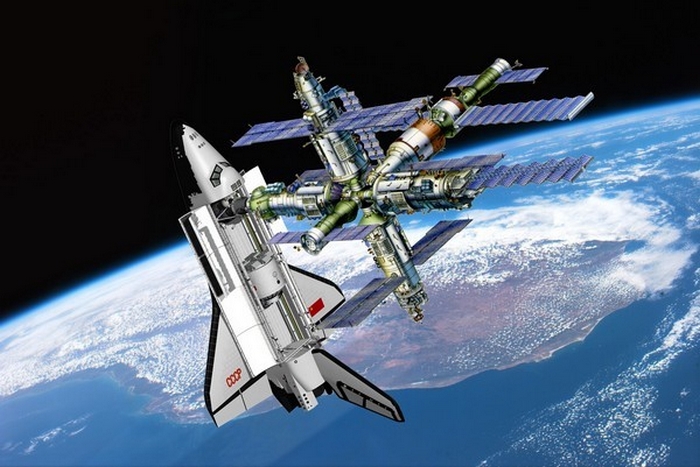
Mir station and space shuttle Buran.
Active work on the construction of the orbital station began in 1979, but was temporarily suspended in 1984 - all the forces of the space industry of the Soviet Union went to the creation of the Buran shuttle. However, the intervention of senior party officials, who planned to launch the facility by the 27th Congress of the CPSU (February 25 - March 6, 1986), made it possible to complete work in a short time and launch Mir into orbit on February 20, 1986.

Base unit of Mir station.
Mir station structure
However, on February 20, 1986, a completely different Mir station, which we knew, appeared in orbit. It was just the base unit, which over time was joined by several other modules that turned Mir into a huge orbital complex connecting living quarters, scientific laboratories and technical premises, including the module for docking the Russian station with the American space shuttle Shuttle ".
At the end of the nineties, the Mir orbital station consisted of the following elements: base unit, modules Kvant-1 (scientific), Kvant-2 (household), Kristall (docking technological), Spectrum (scientific ), "Nature" (scientific), as well as a docking module for American shuttles.

Orbital station Mir in 1999.
It was planned that the assembly of the Mir station would be completed by 1990. But economic problems in the Soviet Union, and then the collapse of the state, prevented the implementation of these plans, and as a result, the last module was added only in 1996.
Purpose of the orbital station Mir
The Mir orbital station is, first of all, a scientific object that allows one to carry out unique experiments on it that are inaccessible on Earth. These are astrophysical studies, and the study of our planet itself, the processes taking place on it, in its atmosphere and in the nearby space.
An important role at the Mir station was played by experiments related to human behavior under conditions of prolonged stay in zero gravity, as well as in the cramped conditions of a spacecraft. It studied the reaction of the human body and psyche to future flights to other planets, and indeed to life in Space, the development of which is impossible without this kind of research.
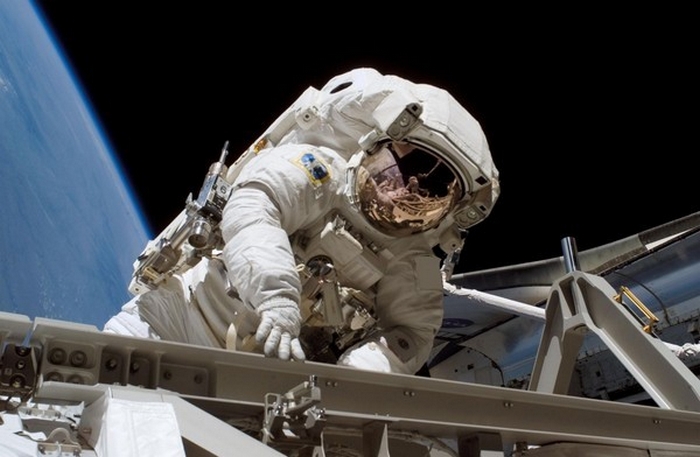
Experiments at Mir station.
And, of course, the Mir orbital station served as a symbol of the Russian presence in space, the national space program, and, over time, the friendship of cosmonauts from different countries.
Mir - the first international space station
The possibility of attracting cosmonauts from other, including non-Soviet countries, to work at the Mir orbital station was originally incorporated into the concept of the project. However, these plans came true only in the nineties, when the Russian space program was experiencing financial difficulties, and therefore it was decided to invite foreign countries to work at the Mir station.
But the first foreign cosmonaut arrived at the Mir station much earlier - in July 1987. It was the Syrian Mohammed Faris. Later, the site was visited by representatives of Afghanistan, Bulgaria, France, Germany, Japan, Austria, Great Britain, Canada and Slovakia. But most of the foreigners on the Mir space station were from the United States of America.
In the early 1990s, the United States did not have its own long-term orbital station, and therefore they decided to join the Russian Mir project. The first American to be there was Norman Tagard on March 16, 1995. This happened within the framework of the Mir-Shuttle program, but the flight itself was carried out on the domestic Soyuz TM-21 spacecraft.
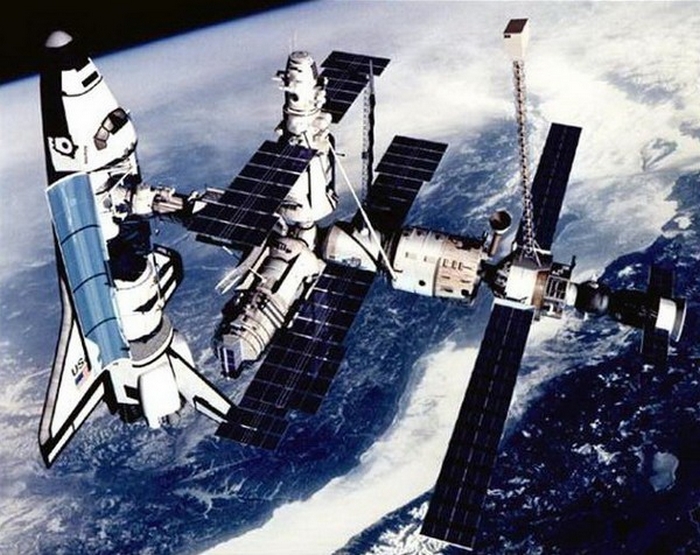
Orbital station Mir and the American shuttle docked with it.
Already in June 1995, five American astronauts flew to the Mir station at once. They got there in the Atlantis shuttle. In total, representatives of the United States have appeared on this Russian space object fifty times (34 different astronauts).
Space records at Mir station
The Mir orbital station is itself a record holder. It was originally planned that it will last only five years and will be replaced by the Mir-2 facility. But funding cuts led to her service life spanning fifteen years. And the time of uninterrupted stay of people on it is estimated at 3642 days - from September 5, 1989 to August 26, 1999, almost ten years (the ISS beat this achievement in 2010).
During this time, the Mir station became a witness and a "home" for many space records. More than 23 thousand scientific experiments have been carried out there. Cosmonaut Valery Polyakov, while on board, spent 438 days continuously (from January 8, 1994 to March 22, 1995), which is still a record achievement in history. And a similar record for women was also set there - the American Shannon Lucid in 1996 stayed in outer space for 188 days (already beaten on the ISS).

Valery Polyakov at Mir station.

Shannon Lucid at Mir Station.
Another unique event that took place on board the Mir station was on January 23, 1993, the first ever space art exhibition. Within its framework, two works by the Ukrainian artist Igor Podolyak were presented.
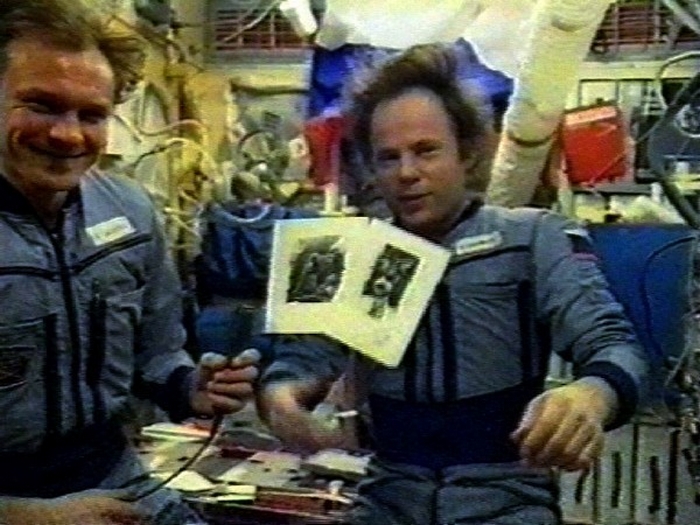
Works by Igor Podolyak at Mir station.
Decommissioning and descent to Earth
Breakdowns and technical problems at the Mir station were recorded from the very beginning of its commissioning. But at the end of the nineties it became clear that its further functioning would be difficult - the object was morally and technically obsolete. Moreover, at the beginning of the decade, a decision was made to build the International Space Station, in which Russia also took part. And on November 20, 1998, the Russian Federation launched the first element of the ISS - the Zarya module.
In January 2001, a final decision was made on the future flooding of the Mir orbital station, despite the fact that there were options for its possible rescue, including the purchase by Iran. However, on March 23, Mir was sunk in Pacific, in a place that is called the Cemetery of Spaceships - it is there that objects that have served their service life are sent to eternal stay.
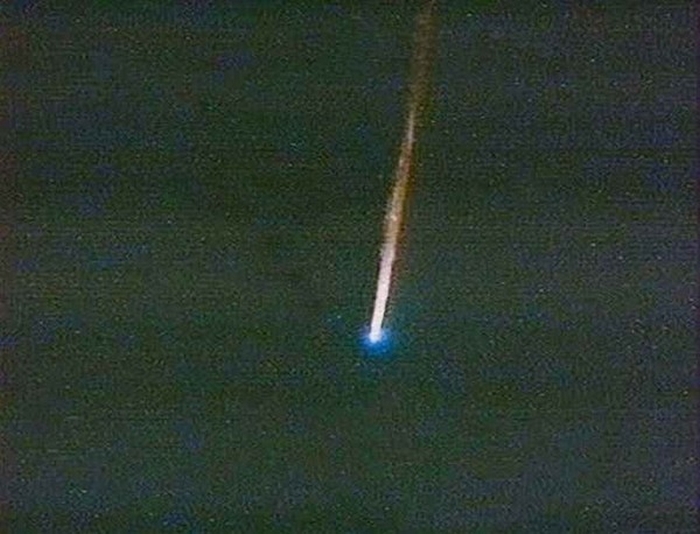
Photo of the historic fall of the orbital station Mir into the Pacific Ocean.
Residents of Australia that day, fearing "surprises" from the long-standing problematic station, jokingly posted on their land plots sights, hinting that it can fall there Russian object... However, the flooding took place without unforeseen circumstances - the "Mir" went under water approximately in the area where it should have been.
Mir Orbital Station Legacy
Mir became the first orbital station built on a modular basis, when many other elements necessary to perform certain functions can be connected to the base unit. This gave impetus to a new round of space exploration. And even with the future creation of permanent bases on planets and satellites, long-term orbital modular stations will still be the basis for a human presence outside the Earth.
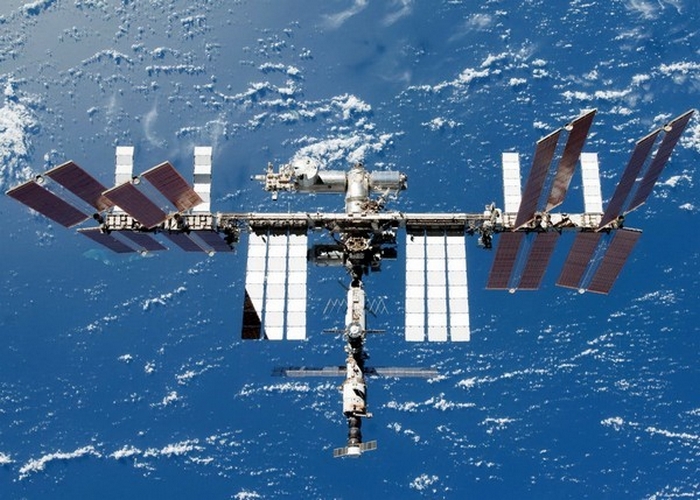
International Space Station.
The modular principle, developed at the Mir orbital station, is now used at the International Space Station. On the this moment, it consists of fourteen elements.




